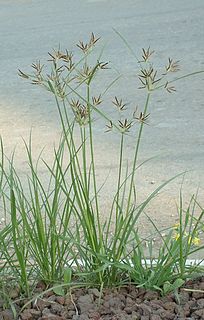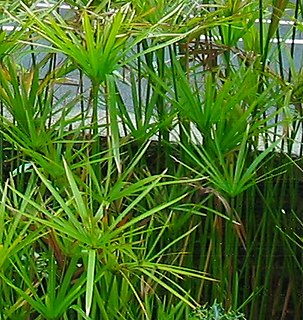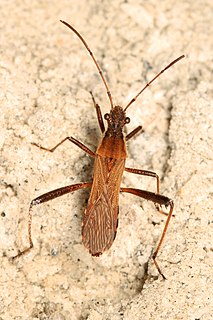
Cyperus papyrus, better known by the common names papyrus, papyrus sedge, paper reed, Indian matting plant, or Nile grass, is a species of aquatic flowering plant belonging to the sedge family Cyperaceae. It is a tender herbaceous perennial, native to Africa, and forms tall stands of reed-like swamp vegetation in shallow water.

The Cyperaceae are a family of graminoid (grass-like), monocotyledonous flowering plants known as sedges. The family is large, with some 5,500 known species described in about 90 genera, the largest being the "true sedges" genus Carex with over 2,000 species.

Cyperus is a large genus of about 700 species of sedges, distributed throughout all continents in both tropical and temperate regions.

Cyperus rotundus is a species of sedge (Cyperaceae) native to Africa, southern and central Europe, and southern Asia. The word cyperus derives from the Greek κύπερος, kyperos, and rotundus is from Latin, meaning "round". The earliest attested form of the word cyperus is the Mycenaean Greek 𐀓𐀞𐀫, ku-pa-ro, written in Linear B syllabic script.

Cyperus alternifolius, the umbrella papyrus, umbrella sedge or umbrella palm, is a grass-like plant in the very large genus Cyperus of the sedge family Cyperaceae. The plant is native to West Africa, Madagascar and the Arabian Peninsula, but widely distributed throughout the world. It has gained the Royal Horticultural Society's Award of Garden Merit. The subspecies Cyperus alternifolius ssp. flabelliformis is also known as Cyperus involucratusRottb..

Cyperus eragrostis is a species of sedge known by several common names, including tall flatsedge, nutgrass, tall nutgrass, umbrella sedge, chufa, Earth almond, zula nuts, edible galingale and pale galingale.

Cyperus fuscus is a species of sedge known by the common name brown galingale, or brown flatsedge. This plant is native to much of Europe, Asia and North Africa from England, Portugal and Morocco east to China and Thailand. It is an introduced species in North America, where it is naturalized in widely scattered locations in the United States and Canada.

Cyperus scariosus is a perennial herbaceous plant from Australia and New Guinea.

Cyperus laevigatus is a species of sedge known by the common name smooth flatsedge.

Bulrush is a vernacular name for several large wetland grass-like plants
Eupogonius pilosulus is a species of beetle in the family Cerambycidae. It was described by Chevrolat in 1862. It is known from Cuba and Jamaica.

Cyperus longus is a species of sedge known by the common names of sweet cyperus and water rush in Africa, or galingale in Britain. It is a tall plant, growing up to a metre in height, with creeping rhizomes and erect, triangular stems, each terminating in an inflorescence. The species grows in shallow water or on damp ground, such as at pond edges.

Alydus pilosulus is a species of broad-headed bug in the family Alydidae. It is found in North America and Oceania.
Ceratocapsus pilosulus is a species of plant bug in the family Miridae. It is found in North America.
Antillocoris pilosulus is a species of dirt-colored seed bug in the family Rhyparochromidae. It is found in North America.

Cyperus flavescens, commonly known as the yellow flatsedge, is a species of flowering plant belonging to the family Cyperaceae.
Cyperus niveus is a species of sedge that is native to parts of Africa, the Middle East and Asia.
Cyperus pannonicus is a species of sedge that is native to parts of south eastern Europe and northern Asia.












